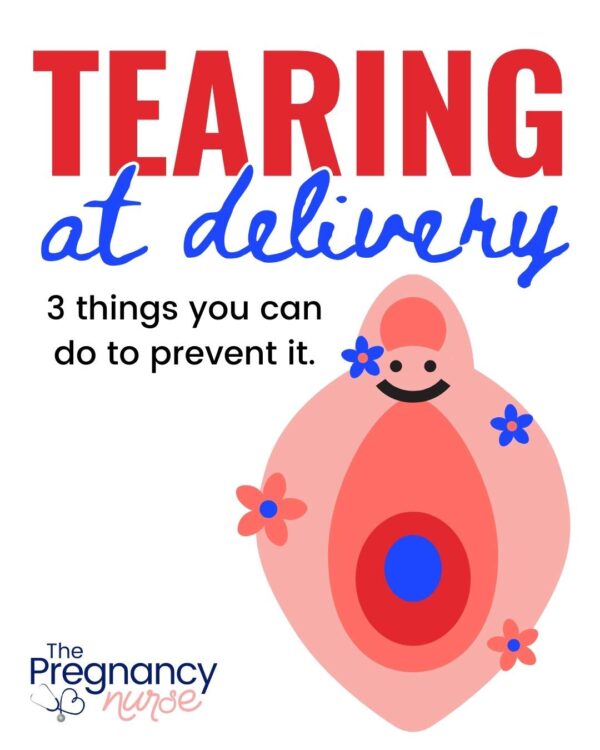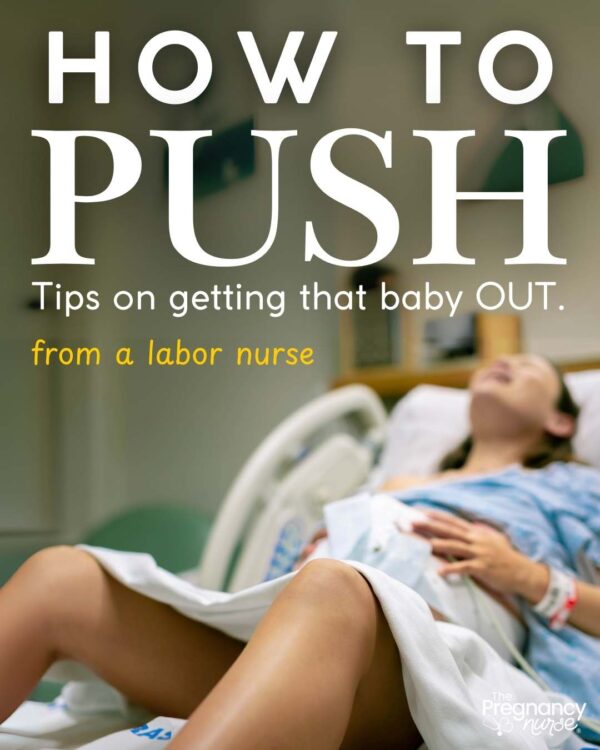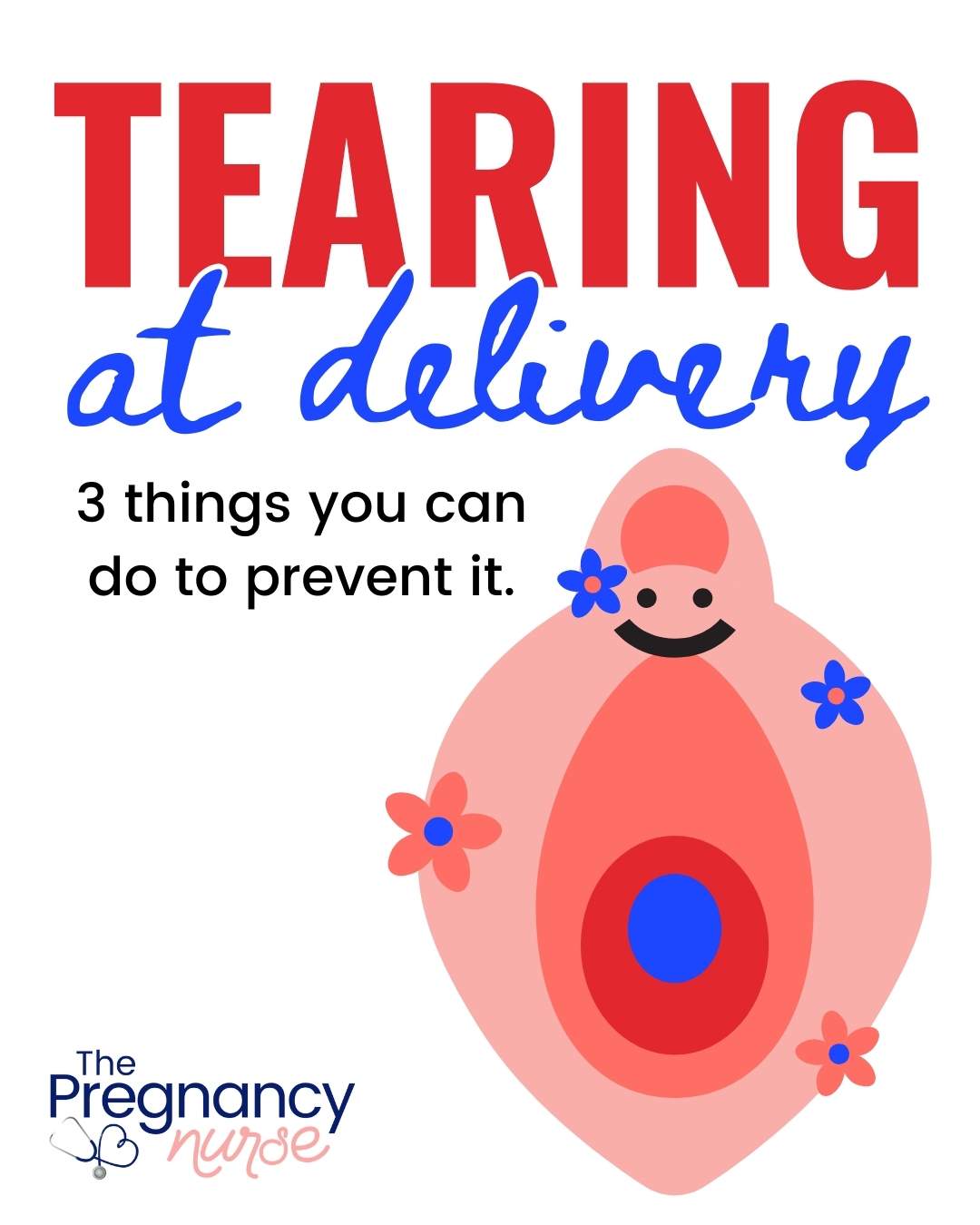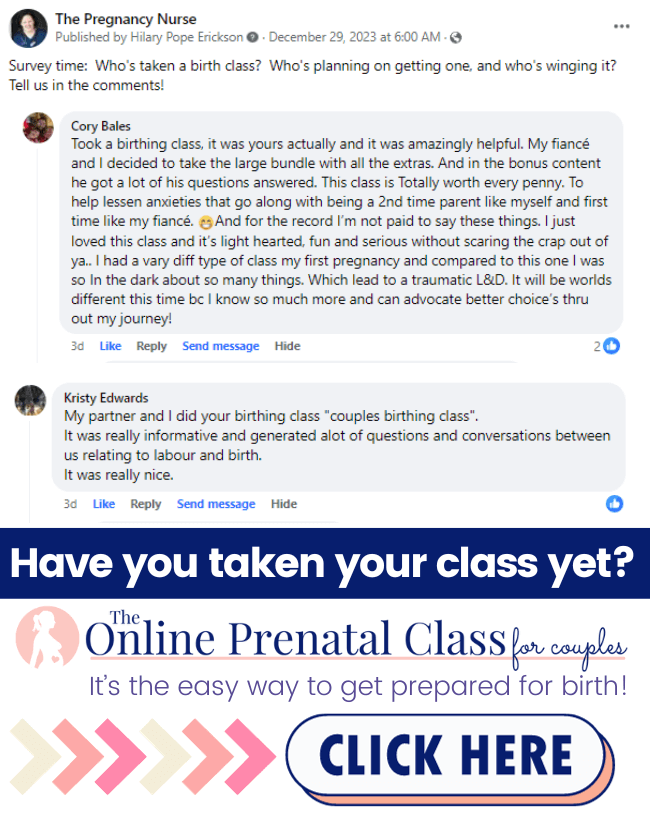Tearing at delivery isn’t anything anyone wants to think about. I get it. However, I wish I had taken a bit more time to realize that it was both highly likely, and a fairly painful recovery on my first baby. Today I have some bad news for you, but also some good news on what you can do to prevent it!

The Bad News:
The bad news is that we really can’t prevent all tears at delivery. There is a lot that goes into it, but no study seems to show any tactic that decreases first and second degree tears.
These are the smaller tears (as one who has experience with a variety of degrees a second is MUCH better than a 3rd or 4th) — they heal better, and are much less likely to have complications.
But, people who are out there saying that they can prevent ALL tears just aren’t true.
SO much has to do with the size of the baby’s head, how well your tissues stretch (which is often genetic), possibly baby’s position… and while we can try to help those (like, marrying someone who had a small head as a baby), we can only do so much.
Tears can be a very normal part of birth.
As I said above I WISH I had been better prepared on what to expect after my first baby both in how it would feel, and how to help myself heal. The birth class I had taken proved to be entirely useless in that arena.
The Online Prenatal Class for Couples is the birth class I wish I had. It is very realistic about what to expect postpartum, and gives you hands-on demonstrations on how to help yourself heal after baby. SO helpful — everyone needs it. PREPARE FOR POSTPARTUM like you prepare for birth (maybe even more).

Want to know more about delivery — check out these posts:
- 5 Simple Tips for a “Natural” Labor & Delivery
- 4 Things to Know About Birth Pains
- Mistakes You’re Making That Makes Labor Longer
- Do You Need a Birth Class if You Plan to Get an Epidural
- Is an Induction More Painful than “Regular Labor”
Perineal Massage
Perineal massage has been proven to help prevent larger tears and episiotomies at delivery. The studies are somewhat mixed (they’re all linked to in that article).
I have seen some studies say that it only worked if it was your first baby, but I have seen others that show it works with any baby (although probably most important on your first as that’s the first time those tissues will stretch like that).
However, not EVERYONE should do perineal massage. Some people who should NOT be doing it:
- If you have any varicose veins in that area
- Any issues with preterm labor you don’t want to try this until you have your providers approval.
- If you’re not planning on a vagainal delivery, there wouldn’t really be a reason to do this (and you maybe shouldn’t depending on the reasons for the cesarean)
A few things to keep in mind:
You’re massaging the PERINEUM — that’s the outermost part of your vagina, the skin area — not inside your vagina.
Lube is your friend, some people just use water, but this shouldn’t be painful, and you don’t want to irritate the tissues there (it may backfire)
You’re focusing on the bottom of the birth canal area closest to your rectum — that is where tissues have to stretch the most.
I would 100% ask your provider for some tips, and make sure it’s safe to do before you attempt it. Most often they don’t recommend starting until around 36 weeks, but you do want some time to work on it — and it maybe takes a few trys to figure out how to do it.
You can also use a friend (hopefully a partner) to do this for you — as it can be tricky to reach that area).
BTW, while we’re talking about things you should be doing later in pregnancy, did you know that kick counts can save 1/3 stillbirths when done correctly. Learn more here:
Warm Washcloth at Delivery
A lot of studies will call this a warm compress, but it’s really just a washcloth with warm water on it. As a nurse I’d swap them out every few pushes to make sure that it’s staying warm. If the washcloths seemed thin (sort of depends on the laundry day at the hospital) I’d sometimes double up on them to make sure it stays warm.
Studies have shown that a warm compress while pushing can decrease your chances of tearing.
This is mainly for people who are pushing for quite a while. If you only push a couple of times, you’re not going to need this (and that nurses is going to keep an eye on that area to make sure baby doesn’t pop out before your doctor does).
As you push, sometimes your perineum swells.
Honestly, sometimes if it swelled a lot I’d alternate between ice and a warm compress (although this is before I saw the studies on warm compresses).
BUT if you’re pushing much past 15 minutes, I’d ask your nurse if she thinks one might help.
While you’re having discussions like this, studies have also shown that providers keeping their hands out while patients push can decrease tearing. This isn’t talking about checking you every 10 or so minutes to see if baby is descending, possibly ascertaining their position (to possibly move YOU into a more favorable position). This is when they stretch your perineum with their hands while you push.
I have seem some studies saying this is NOT helpful and can increase tears, and possibly just generally increase trauma overall to that area.
If you’re not sure what to do — just say I’d prefer you not press on my tissues as we push, could we maybe try a different position instead? Sometimes nurses are compensating because we’re not sure if you want to try something new.
Honestly, learning to talk with the medical staff can be tricky — and a great birth class not only teaches you how to take care of yourself, but also how to speak up for yourself and make choices for yourself at delivery. That’s why I recommend this one — it’s the best at it!
Nurses often feel a lot of pressure to help you push as effectively as you can. When you tell them what you like or don’t like they can help you push better and change things up. Moving, even changing hand or leg positions every few pushes can help you find what you like the best!

Listen To Your Provider
One of the BIG things your provider will do just before baby is born is make sure that you slow your pushing down to gently ease that perineum over the baby’s head (think of it as slipping a tight shirt over their heads).
This means that if they ask you to slow down on your pushes, or to give tiny ones for a bit — listen to them.
The worst tears I’ve seen are people who deliver alone at home and have no one to help their perineum at the end.
One other things that has been shown to help in some studies is lubrication at the end. Some use KY jelly, some use mineral or olive oil. It doesn’t really seem like one works better than others — just what your provider is best at will likely be the best to help at that tricky stage.
What DOESN’T WORK (but everyone seems to think it does.)
Epidural: I see a LOT of people saying an epidural increases your chance of tears. While women who get an epidural may be more likely to have mal-positioned or larger babies there isn’t evidence that they have increased tears overall when confounding for those factors. Study link here.
Birth Position: I also see that the supine position (laying on your back) is bad to tear — but I really appreciated this study that showed that kneeling/all 4’s was the best and squatting may make it worse. Among all that evidence, how you feel best pushing is the best (but also allowing the provider access at the end like we talked about above).
So, there are 3 of the big things that you can do to prevent tearing at your upcoming delivery. Which ones do you think you’ll try — honestly, as long as your provider is OK with them, all three can be helpful.
I wish providers had more time to talk about things like this at your appointments, but they just don’t.
Getting a birth class in gives you a strong foundation of knowledge, so you can spend your appointment time in important things just for YOU. Most providers think you are getting a class, although most couples can’t find one that fits their needs. That’s why The Online Prenatal Class for Couples is the perfect pairing to give you the information YOU need to feel confident about your upcoming birth!
Looking to get prepare for your birth? I have some easy options for you!
~~~~~~~~
– Worried you’re missing something? Grab my pregnancy planner so you don’t miss a thing!
– Thinking about an induction? Grab Inductions Made Easy to feel prepared in just 20 minutes!
– Wondering how to get that baby OUT? Grab Going Into Labor Made Easy so you know how to (and not to) do it!
– Postpartum got you anxious? Check out Postpartum Care Made Easy so you can stay SAFE even when all your attention is on that little on.
🚨 AND if ALL OF IT has got you on edge The Online Prenatal Class for Couples is perfect for you — You’ll feel so ready before you even know it!
~~~~~~~~
No matter WHERE you are at in your pregnancy journey, we have resources that can help!







 5 Simple Tips for a “Natural” Labor & Delivery
5 Simple Tips for a “Natural” Labor & Delivery
